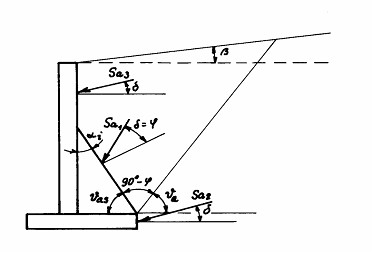Earth - Pressure Wedge
Providing a structure with a cantilever jump (foundation slab of cantilever wall, modification for reduction of earth pressures) is considered when computing earth pressures it is possible to compute earth pressures acting either on the real back of structure with the input angle of friction δ or on an alternate back of structure. The alternate back of structure replaces the real broken one by a slip plane passing from the upper point of the back of wall towards the outer upper point of the jump and forms an earth wedge - see figure. Standardly, a fully mobilized angle of friction δ = φ is assumed along this plane. In all programs, where the earth wedge can be created, the soil/soil friction angle can be reduced in the "Stage settings" frame. The weight of earth wedge created under this alternate back further contributes to load applied to the structure. To introduce the alternate back of structure into the analysis it is necessary to select in the program "Earth pressures" the option "Consider developing of earth-pressure wedge". In other programs the earth wedge is introduced automatically.
 Calculation with and without earth-pressure wedge
Calculation with and without earth-pressure wedge
 Determination of earth-pressure wedge in case of active earth pressure
Determination of earth-pressure wedge in case of active earth pressure
The slip plane of the earth-pressure wedge is inclined from the horizontal line by angle υa given by:
![]()
![]()
![]()
![]()
where: | φ | - | angle of internal friction of soil |
β | - | slope inclination | |
δ | - | ||
γ | - | unit weight of soil | |
α | - | back face inclination of the structure | |
h | - | height of earth wedge |
The shape of the earth wedge in the layered subsoil is determined such that for individual layers of soil above the wall foundation the program computes the angle υa, which then serves to determine the angle υas. Next, the program determines an intersection of the line drawn under the angle υas from the upper right point of the foundation block with the next layer. The procedure continues by drawing another line starting from the previously determined intersection and inclined by the angle υas. The procedure is terminated when the line intersects the terrain or wall surface, respectively. The wedge shape is further assumed in the form of triangle (intersection with wall) or rectangle (intersection with the terrain).